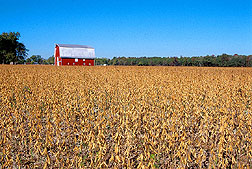This page has been archived and is being provided for reference purposes only. The page is no longer being updated, and therefore, links on the page may be invalid.
|
|
|
|
New Soybean Pulls Nitrogen from Soil, Not Air
By Rosalie Marion BlissDecember 4, 2006
Growers may soon have the option of planting a non-transgenically modified soybean variety that improves recovery of nitrogen from land-applied animal waste. That's thanks to a newly released soybean germplasm that removes large amounts of nitrogen applied to soil. If developed into a new cultivar, it could become an ideal candidate for animal producers managing waste generated by their operations.
The Agricultural Research Service (ARS) released the soybean germplasm, called Nitrasoy, in conjunction with the North Carolina Agricultural Research Service at North Carolina State University in Raleigh. Agronomist Joseph Burton, physiologist Daniel Israel and microbiologist Paul Bishop developed the germplasm. They are with the ARS Soybean and Nitrogen Fixation Research Unit in Raleigh.
Today's commercial nodulating soybean varieties forge a give-and-take relationship with bacteria, called rhizobia, that thrive in the plants' root nodules in soil. The bacteria turn nitrogen gas—which makes up about 80 percent of the atmosphere—into nitrogen fertilizer that the plant can use to make proteins.
Uniquely, Nitrasoy is a non-nodulating soybean germplasm with a large requirement for soil-applied nitrogen to obtain excellent seed yield. Its capacity to recover applied nitrogen from soil reduces the risk of possible nitrate pollution of groundwater.
In field tests, Nitrasoy accumulated up to 17 percent more soil-applied nitrogen in its seed than did its parent, D68-0099. In other tests, Nitrasoy was No. 1 in average seed yield when compared to three other genotypes, after each had been fertilized with swine-lagoon effluent.
Nitrasoy seed has been deposited in the National Center for Genetic Resources Preservation and the National Plant Germplasm System. Nitrasoy seeds are available for research purposes from the ARS lab in Raleigh.
ARS is the U.S. Department of Agriculture's chief scientific research agency.

